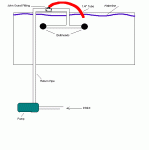I had my new 90g tank drilled for two returns about 3" below the water surface. Once I started planning and setting up everything I realized that during a power outage or when the pump shuts down I will have a major amount of water siphoning off. So, I came up with a design that I hope some of you can comment on. I'll try and explain to the best of my ability here.
From the main return I plumbed the pipe above the water level and installed a tee. then plumbed back down to the returns to branch out to the bulkheads on the back of the tank. Then I installed a 1/4" John Guest tube fitting on the tee. Inserted a length of 1/4" tubing and fixed it to the rim of the tank so it will extend just about a 1/4" below the water's surface.
My theory is if power is cut to the pump the siphon will be broken by the air from the 1/4" tubing. The bulkheads will not be able to drain off once the siphon is broken because the pipe was plumbed slightly above the tank's water level. So, as long as I keep the tubing clean I should be safe from flooding my sump.
Can anyone see any flaws with this design or thought? Will the 1/4" tubing once exposed be able to draw in enough air to break the siphon? I have not tested this on the tank yet because I'm not ready to add water. But, if there is some error in my thinking now is the best time to correct it.
Thanks all!!
Kurt
From the main return I plumbed the pipe above the water level and installed a tee. then plumbed back down to the returns to branch out to the bulkheads on the back of the tank. Then I installed a 1/4" John Guest tube fitting on the tee. Inserted a length of 1/4" tubing and fixed it to the rim of the tank so it will extend just about a 1/4" below the water's surface.
My theory is if power is cut to the pump the siphon will be broken by the air from the 1/4" tubing. The bulkheads will not be able to drain off once the siphon is broken because the pipe was plumbed slightly above the tank's water level. So, as long as I keep the tubing clean I should be safe from flooding my sump.
Can anyone see any flaws with this design or thought? Will the 1/4" tubing once exposed be able to draw in enough air to break the siphon? I have not tested this on the tank yet because I'm not ready to add water. But, if there is some error in my thinking now is the best time to correct it.
Thanks all!!
Kurt







